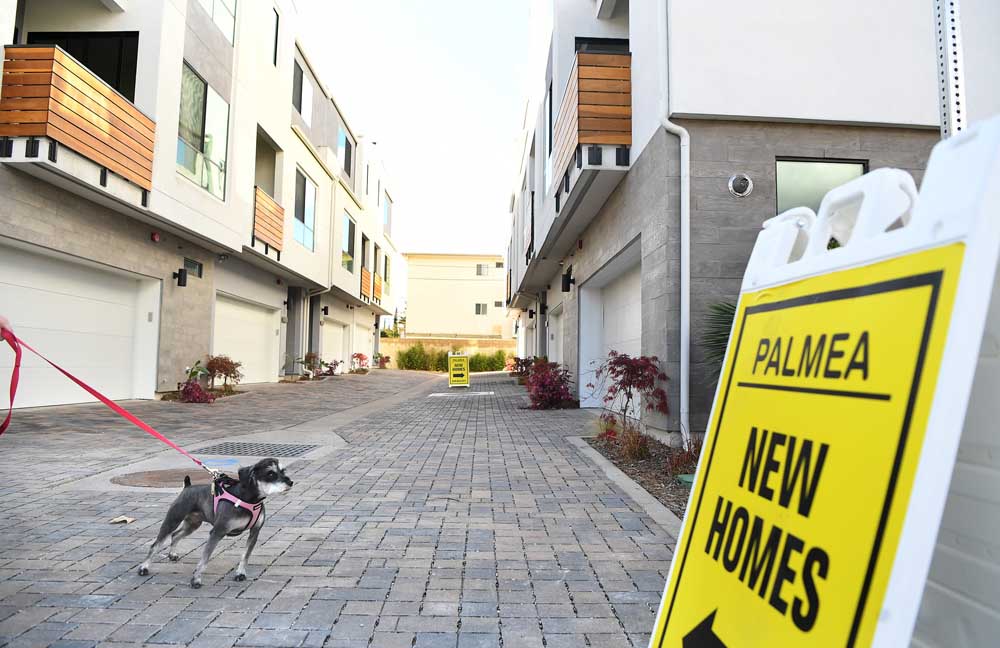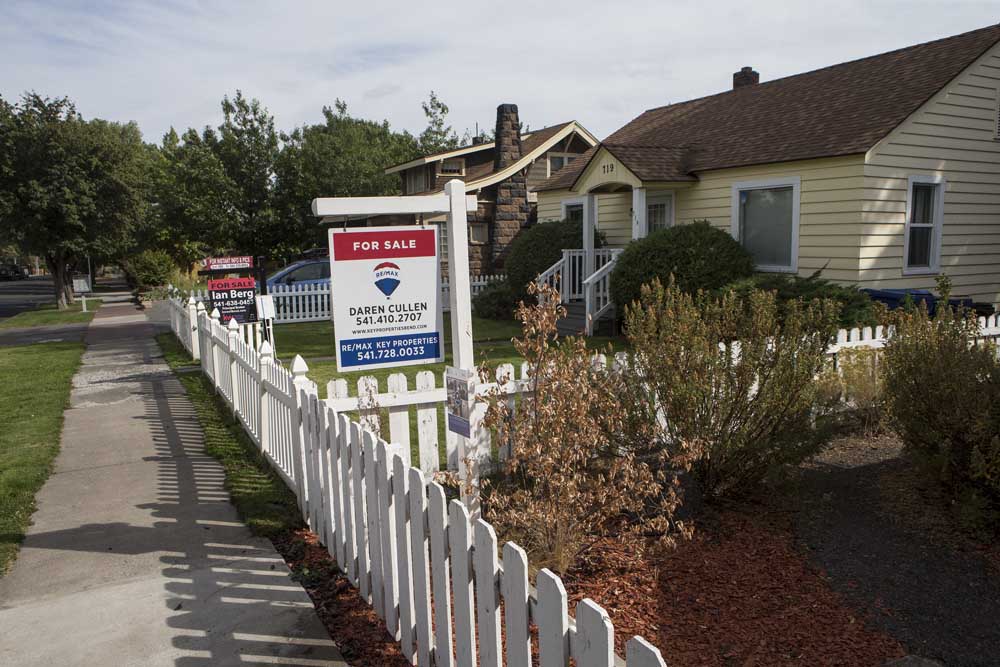As housing market slows, builders are offering discounts
Published 12:00 am Saturday, January 12, 2019

- A dog and its owner walk by a new housing development in North Hollywood. (Wally Skalij/Los Angeles Times/TNS)
LOS ANGELES — As the housing market has downshifted, more builders are offering sweeteners to close the deal.
Companies large and small are paying closing costs, buying down mortgage rates and trimming square footage to offer a cheaper abode. Some are countering the high cost of a mortgage with a more direct method — outright lowering prices on newly built homes.
Trending
“We are really working a little bit harder to get people in the door and to get people excited,” said Mark Mullin, a real estate agent selling several new projects in the Los Angeles area.
At the Gallery, a project in the Valley Village neighborhood of Los Angeles, a builder even offered to pay the lease on a Mini Cooper car if potential buyers agreed to go into escrow on a home.
“These are things they were not having to do a year ago,” said Mullin, who’s not working with the Valley Village builder.
Nationwide surveys indicate concessions are still minor compared to last decade’s downturn, and a recent pullback in mortgage rates could put some heat back into the market. There has been a decided shift in favor of the buyer. A John Burns Real Estate Consulting survey found that in December, 23 percent of builders lowered net prices, which includes list price reductions and incentives such as money toward an upgraded wood floor. A year earlier, only 4 percent dropped prices.
In November, 27 percent of builders were cutting prices. That’s still lower than just after the financial crisis; in 2010, concessions were as high as 43 percent. The housing market slowdown has been particularly pronounced in high-cost markets like California, where the state’s Realtor association says only 27 percent of households can reasonably afford the median priced single-family house.
Sales of all homes dropped 12.5 percent in the three months that ended November, from the same time a year earlier. Prices, which had been rising steadily, slowed considerably.
Trending
New-home data can mask a weak market because a buyer often signs a contract before the home is built, delaying the time the sale shows up in records tracked by CoreLogic.
Rick Palacios, research director with the John Burns consultancy, said builders prefer to offer deals such as money for upgraded appliances before cutting prices outright, because they don’t want people who signed contracts at a higher price to back out. A separate survey from the National Association of Home Builders found the median price cut was 4 percent — a level the group’s chief economist called “measurable, but minor.”
Several months ago, Newport Beach-based Planet Home Living started marketing an eight-home, small-lot community near North Hollywood. It started the cheapest unit at the project at $809,000, but “we weren’t getting the (desired) movement,” Chief Executive Michael Marini said.
So in November he cut prices on the townhome-like units by $10,000 and installed upgraded floors that previously would’ve cost buyers an extra $20,000.
On Jan. 6, Planet Home Living put its strategy to the test with an open house. It was nearly an hour before the first potential buyers showed up and left uninterested.
A short time later, Dominique Worden and her fiance, Shawn, toured the three-story model.
The couple rent in Sherman Oaks and can’t afford a house they’d like there. Worden had been eyeing the project, and Marini’s price drop got her in the door.
“It’s why we came,” she said.
Real estate agent Mullin, who is working with Planet Home, said that by day’s end six groups came through. Potential buyers said they liked the homes, he said, but no one’s put in an offer. Marini said he doesn’t expect to drop prices further and thinks the reduction will be enough to juice demand for the homes.
A number of major builders are reflecting the sales slowdown in their quarterly earnings reports.
KB Home, a company with a major presence in California’s more affordable markets, said in its fourth quarter ended Nov. 30, consumers ordered 2.9 homes each month per community, compared to 3.4 a year earlier.
In the three months ended Oct. 31, Pennsylvania-based luxury homebuilder Toll Bros. saw signed contracts in California fall by nearly half, from 10.4 per community during the quarter to 5.8. California saw the largest drop-off of its markets.
John Mulville, the Southern California regional director for research firm Metrostudy, said there’s more fear among companies that focus on pricier homes. Even in good times, there are few people who can afford a house above $1.5 million.
To stave off jitters, Mulville said builders are “hand-holding” clients through the homebuilding process and offering more concessions if they threaten to cancel.
It’s not always working. Metrostudy data show cancellations in Southern California are up compared to a year earlier.
Builders and agents blame a variety of factors for ebbing demand. Fewer buyers can afford homes following a jump in mortgage rates in 2018 and more than six years of steady price increases. Some of those who can afford a mortgage believe prices simply can’t keep rising, and don’t want to buy at the top.
While predicting a collapse is always a fraught business, economists, citing strong job growth and relatively tight lending standards, generally don’t foresee a crash.
They do disagree on exactly what comes next.
Some experts believe price growth is simply slowing as buyers adjust to higher rates. Others think values will come down, arguing they have gotten too far out of whack with incomes.
Many families struggling to afford a mortgage in California coastal markets would cheer price declines. On quarterly earnings calls, major home builders are quick to point out a variety of factors that would continue to put upward pressure on values. Not only is job growth proceeding despite uncertainty, the large millennial population is entering prime home-buying years and oversupply doesn’t appear to be a looming problem.
In California, builders on average have constructed an average of 91,000 homes a year during the current housing upswing, according to data from the Construction Industry Research Board. That compares to an average of 158,000 a year during the boom of the late 1990s to mid 2000s. In the 1980s housing expansion, construction averaged 267,000 units a year.
Builders may have gotten too aggressive on pricing.
On a recent single-family project in downtown Huntington Beach, luxury builder WJK Development tried unsuccessfully to push prices up to $2.2 million, 10 percent above the previous per-square-foot record for the area.
“We took prices beyond the realm of reality,” said Grant Keene, chief executive of the Irvine company. “It made consumers balk.”
A surer picture will emerge in the spring, when many families usually launch their home search.
One thing that may boost demand is a steady decline in mortgage rates from a high of 4.94 percent in November.
This week, Freddie Mac said the average for a 30-year fixed mortgage was 4.45 percent, still up considerably from 3.99 percent a year earlier but at its lowest level since April.
The drop-off has been caused in large part by uncertainty surrounding the economy, but there are signs it helped spur a recent burst in mortgage applications.
Interest has perked up at the Valley Village development, for instance, and for now the builder is no longer marketing the Mini Cooper lease, said Marc Tahler, the property’s agent.
Others see better times ahead.
“I believe spring should be a pretty healthy, normal selling season,” Douglas Bauer, chief executive of Irvine-based home builder TRI Pointe Group Inc., said in an interview.
Not everyone is so sure. According to Tom Dallape, co-owner of prominent local land broker the Hoffman Co., some builders have backed out of buying lots they had previously agreed to scoop up.
They didn’t want to move forward, Dallape said, because they wanted to “see what happens in the spring.”








